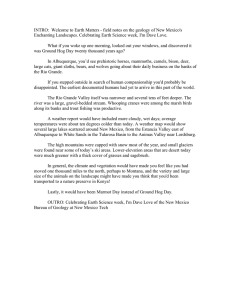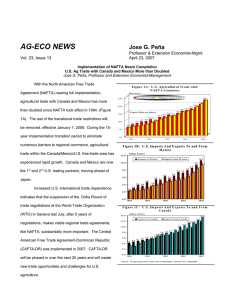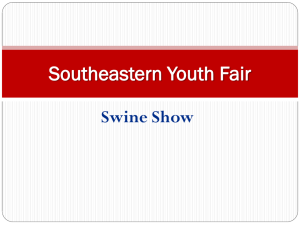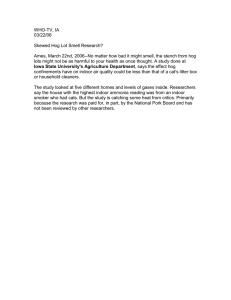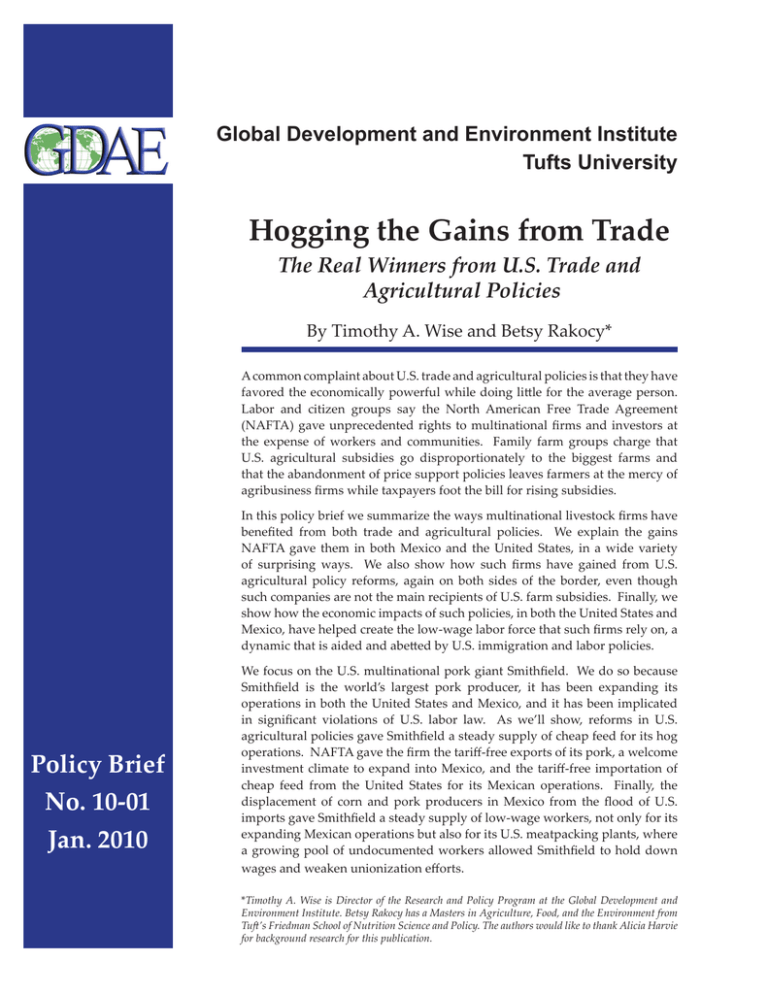
Global Development and Environment Institute
Tufts University
Hogging the Gains from Trade
The Real Winners from U.S. Trade and
Agricultural Policies
By Timothy A. Wise and Betsy Rakocy*
A common complaint about U.S. trade and agricultural policies is that they have
favored the economically powerful while doing li�le for the average person.
Labor and citizen groups say the North American Free Trade Agreement
(NAFTA) gave unprecedented rights to multinational firms and investors at
the expense of workers and communities. Family farm groups charge that
U.S. agricultural subsidies go disproportionately to the biggest farms and
that the abandonment of price support policies leaves farmers at the mercy of
agribusiness firms while taxpayers foot the bill for rising subsidies.
In this policy brief we summarize the ways multinational livestock firms have
benefited from both trade and agricultural policies. We explain the gains
NAFTA gave them in both Mexico and the United States, in a wide variety
of surprising ways. We also show how such firms have gained from U.S.
agricultural policy reforms, again on both sides of the border, even though
such companies are not the main recipients of U.S. farm subsidies. Finally, we
show how the economic impacts of such policies, in both the United States and
Mexico, have helped create the low-wage labor force that such firms rely on, a
dynamic that is aided and abe�ed by U.S. immigration and labor policies.
Policy Brief
No. 10-01
Jan. 2010
We focus on the U.S. multinational pork giant Smithfield. We do so because
Smithfield is the world’s largest pork producer, it has been expanding its
operations in both the United States and Mexico, and it has been implicated
in significant violations of U.S. labor law. As we’ll show, reforms in U.S.
agricultural policies gave Smithfield a steady supply of cheap feed for its hog
operations. NAFTA gave the firm the tariff-free exports of its pork, a welcome
investment climate to expand into Mexico, and the tariff-free importation of
cheap feed from the United States for its Mexican operations. Finally, the
displacement of corn and pork producers in Mexico from the flood of U.S.
imports gave Smithfield a steady supply of low-wage workers, not only for its
expanding Mexican operations but also for its U.S. meatpacking plants, where
a growing pool of undocumented workers allowed Smithfield to hold down
wages and weaken unionization efforts.
*Timothy A. Wise is Director of the Research and Policy Program at the Global Development and
Environment Institute. Betsy Rakocy has a Masters in Agriculture, Food, and the Environment from
Tu�’s Friedman School of Nutrition Science and Policy. The authors would like to thank Alicia Harvie
for background research for this publication.
GDAE Policy Brief No. 10 - 01 January 2010
Feeding at the Trough of U.S. Agricultural Policy
Gains for firms such as Smithfield were partly the result of changes to U.S. agricultural
policies. The 1996 Farm Bill was the final nail in the coffin of agricultural supply-management
policies which had been the basis of U.S. farm policy since the Great Depression. Their
demise meant that the U.S. government no longer used a mix of price supports, reserves, and
land set-asides to manage the precarious balance between supply and demand, a balance
that o�en resulted in supplies outstripping demand and prices falling to unsustainable
levels. Those policies had the goals of keeping prices profitable for farmers, affordable for
consumers, and relatively stable for both. A�er 1996, the goal was to provide limited income
support to farmers while ge�ing the government out of agricultural commodity markets
and allowing prices to fall or rise according to market signals.
Total Savings from Low Feed Prices, 1997-2005
Top Four Hog-Producing Companies
Company
Market Share*
Smithfield
Premium Standard
Seaboard Corp.
Prestage
30%
8%
7.5%
5%
Total Savings Annual Savings
97-'05**
97-'05***
$2.54 billion
$680 million
$638 million
$426 million
$284 million
$76 million
$71 million
$47 million
*Constant 2003 market share
**Savings is equal to the difference between the market price of hog feed and feed priced at the full cost of production.
Production costs based on USDA/ERS estimates of total economic costs of production for corn and soybean meal, the main
components of hog feed. Between 1997 and 2005, hog feed was sold on the open market at an average of 26% below cost of
production.
***
Average annual savings over the 9-year period. Actual savings varied from year to year
Source: Starmer and Wise (2006), based on data from USDA/ERS 1996-2005
The reforms created an immediate
crisis. Millions of acres of land that
had been held out of agriculture
came back into production. Land
planted to eight major U.S. crops
increased 6% and crop prices fell
40%, prompting a farm crisis that
threatened to provoke a run on
rural banks. The government
stepped in with a series of
emergency payments to farmers,
which evolved into the mix of
farm subsidies we see to this day.
Farm program costs increased
from their pre-1996 levels of
around $10 billion per year to
around $20 billion per year.1
More important for firms such as Smithfield, the economic burden of U.S. farm programs
shi�ed from consumers of farm products– mostly agribusiness firms – in the form of
supported prices to U.S. taxpayers, who foot the bill for farm subsidies. Most U.S. row
crops are sold not as food to consumers but as raw material to agribusinesses – feedlots,
food companies, clothing makers, etc. Suddenly, these businesses saw a steady oversupply
of raw materials at low prices. In fact, from 1997 through 2005, until the recent run-up in
commodity prices, agribusiness firms were paying prices below the costs of production for
many of their agricultural raw materials.
Feed is by far the largest operating expense for industrial hog and poultry operations, and
feed is made up principally of corn and soybeans. We estimated that from 1997-2005 corn
was sold at 23% below the average costs of production, while soybeans sold for 15% below
cost. This “implicit subsidy” to animal feed gave industrial hog farmers a 26% break on their
feed costs, which represented a 15% reduction in the firms’ operating costs.2
We estimated savings to the industry from below-cost feed at $8.5 billion over that nineyear period. Smithfield controlled roughly 30% of the hog market during that time, so its
savings were about $2.5 billion.3 This gave Smithfield a competitive advantage, not over
other industrial hog producers in the United States; they too benefited from below-cost feed.
But it gave them all an edge over diversified hog farms on which farmers grew their own
corn, soy and other fodder for their animals.
2
GDAE Policy Brief No. 10 - 01 January 2010
NAFTA: Working Both Sides of the Border
Smithfield and other industrial livestock firms also gained a competitive advantage over
many Mexican hog producers, an edge that grew in importance with the implementation
of NAFTA in 1994. From the early 1990s to 2006-8, pork exports to Mexico increased over
700%, making Mexico the second most important export market for U.S. pork. With the
implicit subsidy to feed, U.S. exporters could sell their pork at prices 10% below the prices
they would have had to charge if they had paid full cost for their corn and soybeans between
1997 and 2005.4
This gave firms like Smithfield an added advantage over their Mexican competitors,
at least over those hog farmers who were still growing their own feed or buying it from
local farmers. Pork prices in Mexico fell 56% in real terms from the early 1990s until 2005.
The restructuring of the Mexican hog industry, accelerated by the flood of imports from
the United States and by the implicit subsidy to prices, put many small and mid-sized hog
farmers out of business.
NAFTA’s benefits for Smithfield and other industrial hog firms went much further. The
treaty liberalized investment rules, which meant that the Mexican government was no
longer allowed to impose restrictions on foreign investors. The Mexican government, which
was already moving away from such policies before NAFTA, had previously banned 100%
foreign ownership, insisted firms supply their operations with local inputs, mandated they
hire and train local technical staff, and imposed a variety of other measures designed to
ensure foreign investment stimulated local economic development.
NAFTA’s implementation coincided with a period of international expansion for Smithfield.
Soon a�er the treaty was signed, the firm set up a joint venture hog-feeding operation
in Veracruz. It later purchased a major interest in Granjas Carroll’s vast production and
feeding operation, and entered into another joint venture with producer/processor Norson.
Transnational firms now control an estimated 35% of Mexico’s pork industry, and Smithfield
may well account for half of that.
And how did Smithfield feed its expanding hog herds in Mexico? With feed made from
imported U.S. corn and soybeans, which also flooded Mexico under NAFTA. The Mexican
government declined to enforce NAFTA’s tariff-rate quota system, a transition period put in
place to prevent import surges in key products such as corn. With no significant restrictions
on corn or soybean imports, Mexico saw corn imports quintuple from their levels in the
early 1990s, while soybean imports jumped more than 150%.
This was a boon to industrial livestock firms like Smithfield. Corn came into Mexico from
1997-2005 at prices 19% below U.S. production costs. Soybeans saw a “dumping margin” of
12%. The resulting savings on feed helped Smithfield and other industrial livestock firms
expand their operations in Mexico.
Filling the Pool of Cheap Labor
Cheap imported corn and soybeans benefited Smithfield and other industrial livestock
firms in other ways. By 2005, real prices in Mexico for both crops dropped by two-thirds
from their levels in the early 1990s. Rising imports of cheap commodities put tremendous
economic pressure on Mexican producers, particularly the three million farmers who grow
corn. The result has been a massive exodus from agriculture, as farm families le� the land or
sent family members to other parts of Mexico or to the United States in search of work. An
estimated 2.3 million people le� agriculture between 1993 and 2008.5
Where did they find work? Some of them joined displaced hog farmers as wage laborers
in Smithfield’s expanding Mexican operations. Others found their way to the United
States, where some found work in the largely low-wage, non-union meatpacking industry.
3
GDAE Policy Brief No. 10 - 01 January 2010
Undocumented workers now make up more than one-quarter of the work force in “animal
slaughter.”6 There is evidence that meatpackers intentionally hire undocumented workers
to drive down wages and undercut unionization efforts. Human rights organizations have
documented such practices at Smithfield.7
U.S. immigration and labor policies have helped sustain this low-wage work force for
industrial livestock producers, adding to the boon from trade and agricultural policies.
The United States did not liberalize the flow of labor under NAFTA, only the flows of
goods, services, and capital. In fact, the U.S. government has increasingly criminalized
undocumented immigration, particularly following the September 11, 2001 terrorist a�acks.
While trade and agricultural policies have increased the “push factors” that force Mexicans
to leave home to sustain their livelihoods, immigration policies have made their existence in
the United States increasingly precarious. Mexican migration to the United States roughly
doubled since the early 1990s. Stepped up border enforcement has had the unintended
consequence of deterring seasonal migration from Mexico, causing more of those migrants
to remain in the United States permanently.8 This growing pool of highly insecure workers
has given meatpackers and other industries the low-wage work force they desire.
Meanwhile, lax enforcement of weak U.S. labor laws made it very difficult for workers to
defend themselves through unionization. The successful union drive in 2008 at Smithfield’s
vast Tar Heel plant is the exception that proves the rule. The United Food and Commercial
Workers spent 15 years trying to organize workers there, enduring a well-documented
series of labor rights violations, including conscious efforts to pit African-American workers
against Latinos and undocumented workers against those with legal status.9 The National
Labor Relations Board did not rule on the 1994 and 1997 illegal firing of pro-union workers
until 2000. Weak U.S. labor protections, combined with weak enforcement, gave Smithfield
a further economic advantage.
Conclusion
The confluence of agriculture, trade, immigration, and labor policies have pushed cheap
commodities south and driven people north. Every step of the way, and on both sides of the
U.S.-Mexican border, transnational industrial livestock firms have benefited economically
from such policies. They have go�en cheap feed for their animals, a favorable investment
climate in Mexico, tariff-free exports of finished products and tariff-free imports of feed,
and a growing supply of low-wage labor on both sides of the border. Government policies
inevitably create winners and losers. It is clear that Smithfield and other large livestock
firms stand with the winners.
4
GDAE Policy Brief No. 10 - 01 January 2010
Endnote
Ray, D. E., D. G. De La Torre Ugarte, et al. (2003). Rethinking U.S. Agricultural Policy: Changing Course to
Secure Farmer Livelihoods Worldwide. Knoxville, TN, Agricultural Policy Analysis Center, The University
of Tennessee.
2
Starmer, E. and T. A. Wise (2007). Living High on the Hog: Factory Farms, Federal Policy, and the Structural
Transformation of Swine Production. Medford, MA, Global Development and Environment Institute.
3
Starmer, E. and T. A. Wise (2007). Industrial Livestock Companies’ Gains from Low Feed Prices. GDAE
Policy Brief No. 07-01. Medford, MA, Global Development and Environment Institute.
4
Data for this section are largely drawn from: Wise, T. A. (2009). Agricultural Dumping Under NAFTA:
Estimating the Costs of U.S. Agricultural Policies to Mexican Producers. GDAE Working Paper No. 09-08.
Medford, MA, Global Development and Environment Institute, Tu�s University.
5
Zepeda, E., T. A. Wise, et al. (2009). Rethinking Trade Policy for Development: Lessons from Mexico under
NAFTA. Policy Outlook. Washington, DC, Carnegie Endowment for International Peace.
6
Goldsmith, P. and P. L. Martin (2006). “Community and Labor Issues in Animal Agriculture.” Choices 21(3):
183-187.
7
Human Rights Watch (2004). Blood, Sweat and Fear: Workers’ Rights in U.S. Meat and Poultry Plants. New
York, NY, Human Rights Watch, Tanger, S. E. (2006). “Enforcing Corporate Responsibility for Violations of
Workplace Immigration Laws: The Case of Meatpacking “ Harvard Latino Review 59: 59-90.
8
Zepeda et al. (2009).
9
Goumbri, M. (2007). Blacks, Latinos Unite in Drive to Unionize. New America Media. San Francisco, CA,
McGolrick, S. J. (2008). Smithfield, UFCW Se�le RICO Suit, Agree to Election Using ‘Fair Process’. The
1
Bureau of National Affairs, Inc. Professional Information Center: Employment & Labor Law. Arlington, VA.
Corresponding author: Timothy A. Wise, tim.wise@tu�s.edu.
Suggested citation: Wise, Timothy A. and Rakocy, Betsy “Hogging the Gains from Trade: The Real
Winners from U.S. Trade and Agricultural Policies,” GDAE Policy Brief 10-01, Medford, Mass.: Global
Development and Environment Institute, Tu�s University, January 2010.
Download: h�p://www.ase.tu�s.edu/gdae/Pubs/rp/PB10-01HoggingGainsJan10.pdf
© Copyright 2010 Global Development and Environment Institute
Tu�s University, 44 Teele Avenue, Medford, MA 02155 USA
TEL: 617 627-3530 • FAX: 617 627-2409 • E-MAIL: GDAE@tu�s.edu
WEB SITE: h�p://ase.tu�s.edu/gdae
All rights reserved. This document may be freely reproduced, in whole or in part, provided the original
source is acknowledged.
The Global Development And Environment Institute (GDAE) is a research institute at Tu�s University
dedicated to promoting a be�er understanding of how societies can pursue their economic and
community goals in an environmentally and socially sustainable manner. GDAE pursues its mission
through original research, policy work, publication projects, curriculum development, conferences
and other activities.
5


